Top Rankings
Kirkwood R-VII School District ranks among the top 20% of public school district in Missouri for:
Category
Attribute
Overall Rank
Highest overall rank (Top 5%)
Math Proficiency
Highest math proficiency (Top 5%)
Reading/Language Arts Proficiency
Highest reading/language arts proficiency (Top 5%)
Science Proficiency
Highest science proficiency (Top 5%)
Graduation Rate
Highest graduation rate (Top 1%)
Diversity
Most diverse schools (Top 1%)
Community Size
Largest student body (number of students) (Top 1%)
For the 2025 school year, there is 1 public preschool serving 299 students in Kirkwood R-VII School District.
Public Preschools in Kirkwood R-VII School District have a diversity score of 0.37, which is less than the Missouri public preschool average of 0.54.
Minority enrollment is 21% of the student body (majority Black), which is less than the Missouri public preschool average of 36% (majority Black).
Overview
This School District
This State (MO)
# Schools
9 Schools
733 Schools
# Students
6,096 Students
201,896 Students
# Teachers
459 Teachers
18,018 Teachers
Student : Teacher Ratio
13:1
13:1
District Rank
Kirkwood R-VII School District, which is ranked within the top 5% of all 553 school districts in Missouri (based off of combined math and reading proficiency testing data) for the 2021-2022 school year.
The school district's graduation rate of 97% has decreased from 99% over five school years.
Overall District Rank
#15 out of 557 school districts
(Top 5%)
(Top 5%)
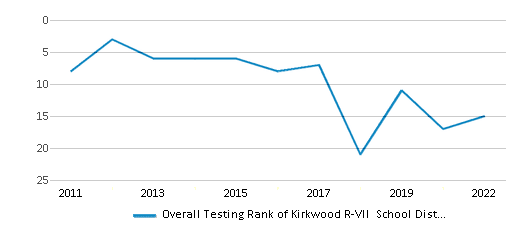
Math Test Scores (% Proficient)
61%
39%
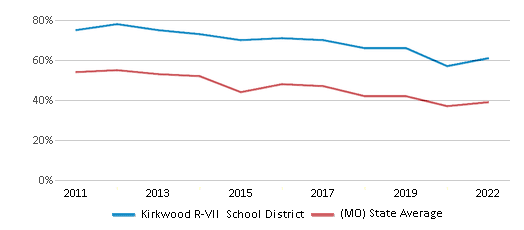
Reading/Language Arts Test Scores (% Proficient)
66%
43%
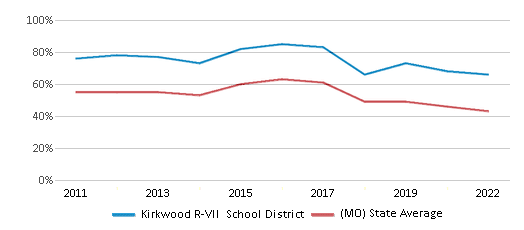
Science Test Scores (% Proficient)
56%
38%
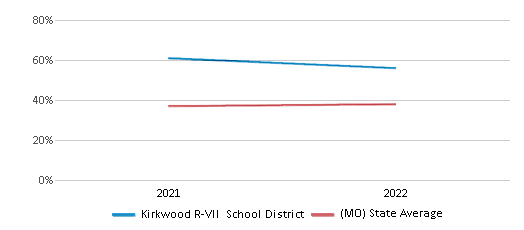
Graduation Rate
97%
90%
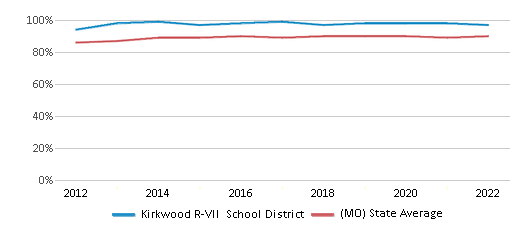
Students by Ethnicity:
Diversity Score
0.37
0.54
# American Indian Students
12 Students
716 Students
% American Indian Students
n/a
n/a
# Asian Students
73 Students
3,353 Students
% Asian Students
1%
2%
# Hispanic Students
274 Students
17,293 Students
% Hispanic Students
4%
9%
# Black Students
528 Students
39,639 Students
% Black Students
9%
20%
# White Students
4,802 Students
129,832 Students
% White Students
79%
64%
# Hawaiian Students
6 Students
837 Students
% Hawaiian Students
n/a
n/a
# Two or more races Students
401 Students
10,226 Students
% of Two or more races Students
7%
5%
Students by Grade:
# Students in PK Grade:
299
35,559
# Students in K Grade:
414
31,533
# Students in 1st Grade:
449
29,607
# Students in 2nd Grade:
470
29,116
# Students in 3rd Grade:
481
23,532
# Students in 4th Grade:
463
22,982
# Students in 5th Grade:
470
19,323
# Students in 6th Grade:
444
6,065
# Students in 7th Grade:
429
1,923
# Students in 8th Grade:
440
1,863
# Students in 9th Grade:
408
85
# Students in 10th Grade:
420
51
# Students in 11th Grade:
452
37
# Students in 12th Grade:
457
220
# Ungraded Students:
-
-
District Revenue and Spending
The revenue/student of $17,645 is higher than the state median of $15,081. The school district revenue/student has stayed relatively flat over four school years.
The school district's spending/student of $13,486 is less than the state median of $13,908. The school district spending/student has stayed relatively flat over four school years.
Total Revenue
$108 MM
$13,447 MM
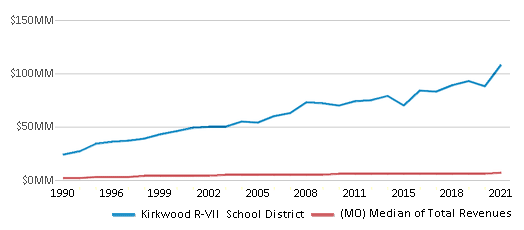
Spending
$82 MM
$12,401 MM
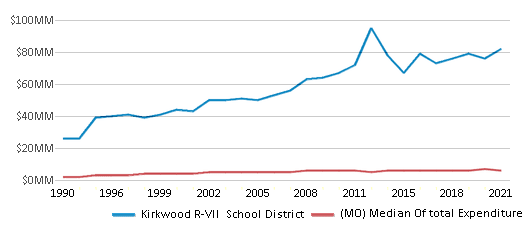
Revenue / Student
$17,645
$15,081
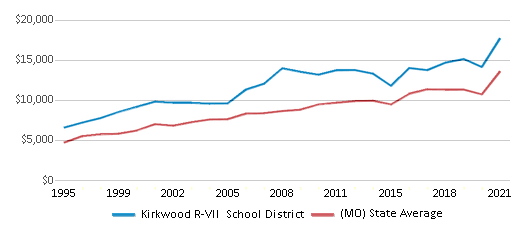
Spending / Student
$13,486
$13,908
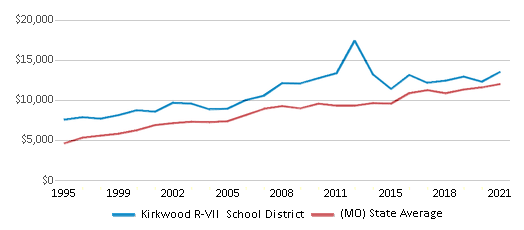
Best Kirkwood R-VII School District Public Preschools (2025)
School
(Math and Reading Proficiency)
(Math and Reading Proficiency)
Location
Grades
Students
Rank: n/an/a
100 S Sappington Rd
Saint Louis, MO 63122
(314) 213-6136
Saint Louis, MO 63122
(314) 213-6136
Grades: PK
| 299 students
Recent Articles

Sexual Harassment at Age 6: The Tale of a First Grade Suspension
A six-year old in Aurora, Colorado, was suspended after singing an LMFAO song to a little girl in his class and reportedly “shaking his booty.” We look at the case and the sexual harassment problem in public schools today.

How Scaffolding Could Change the Way Your Child Learns
This article explores the concept of instructional scaffolding, a teaching method that enhances learning by breaking down complex tasks into manageable parts. It highlights how scaffolding supports students in developing critical thinking skills and becoming more independent learners. The article discusses the benefits of scaffolding, including improved engagement and reduced anxiety, and provides strategies for its implementation across various educational levels.

February 05, 2025
Understanding the U.S. Department of Education: Structure, Impact, and EvolutionWe explore how the Department of Education shapes American education, from its cabinet-level leadership to its impact on millions of students, written for general audiences seeking clarity on this vital institution.





